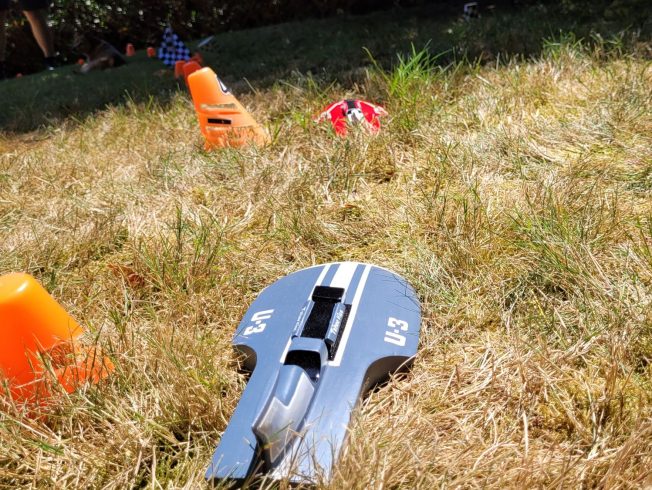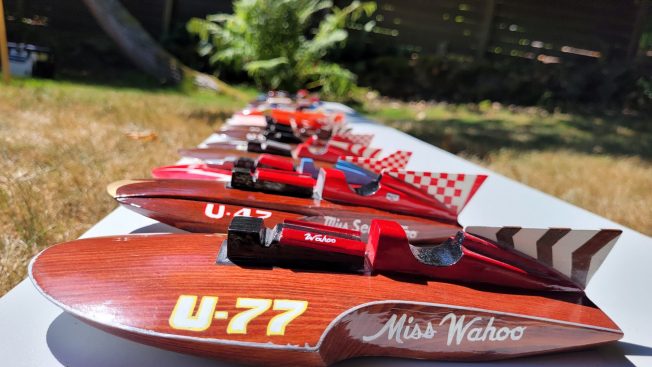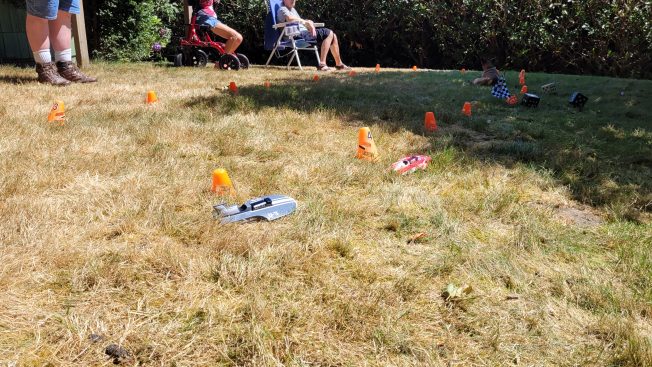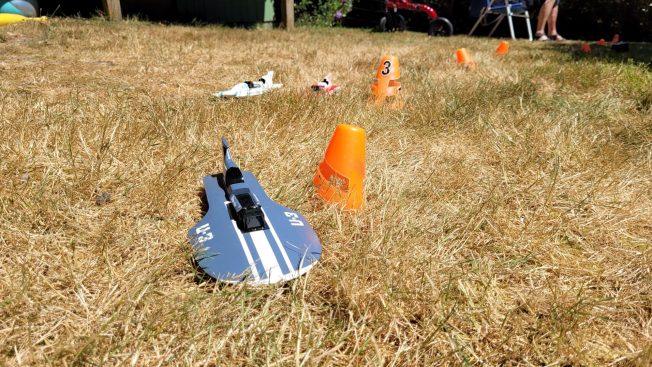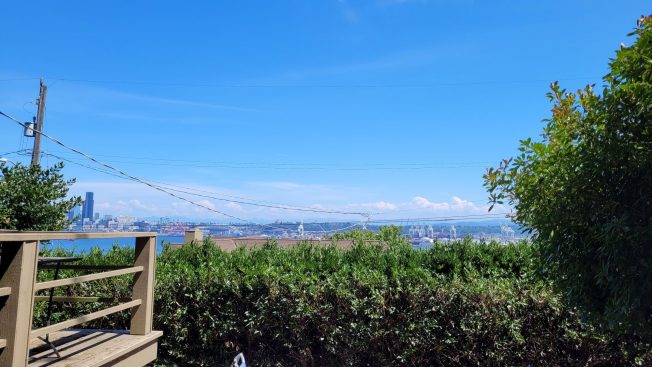Your cart is currently empty!
After 60 years, lifelong friends retire the lawn-racing mini-hydros of the American Turf Power Boat Association
By Hayden Yu Andersen
Reporting for West Seattle Blog
At noon this past Wednesday, in a sunny backyard behind a house at the end of Victoria Avenue SW, 60 years of history culminated in a tense competition between five childhood rivals. The sleek, bat-winged profile of the Myr Sheet Metal rocketed ahead of the blunt-nosed Grey Ghost and the bright red Exide in an all-or-nothing bid for the finish line. The Sheet Metal’s driver, Brian Partridge, cheered uproariously as he took home the trophy in the final race of the American Turf Power Boat Association.
The five men traded light-hearted barbs as they retrieved their boats. Each one is a scaled-down replica of a hydroplane, painted meticulously to resemble a specific real-life counterpart. These models are a testament to one of Seattle’s longest-running traditions, the Seafair hydroplane races. Since 1950, crowds have been drawn to the banks of Lake Washington to watch drivers reach speeds upward of 200 MPH as they race neck-and-neck for the Seafair Cup.
James Jay Wilson says he can still remember the roaring of the Rolls-Royce Merlin engines over Lake Washington during Seattle’s first-ever Hydroplane race. James -or as his friends call him, “Wahoo” – was obsessed. This obsession would quickly spiral outward, as other kids on Victoria Avenue began to follow along. James calls it “hydro fever,” and it’s had its grip on him and his friends for the last 60 years.
Randy Short, a friend of Wilson’s, said he remembers hearing Wilson towing a small wooden recreation of that year’s hydroplane behind his bike, a gift from his father. This quickly turned into a sport as Short and Wilson formed an alliance, racing their boats around Victoria Avenue. Later that decade, what started as a bike race evolved into a lawn game, the Turf Thunderboat Game, and what started as a group of friends eventually became the ATPBA, the American Turf Power Boat Association.
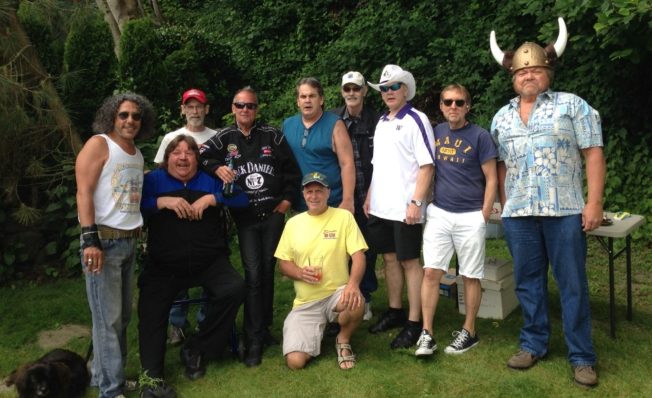 (Group photo from a previous race, this photo and sixth photo courtesy James Wilson)
(Group photo from a previous race, this photo and sixth photo courtesy James Wilson)
The rules of the game are simple. A “track” is set up using cones, each marking a spot in the race. Every contestant places their boat at the starting line, and each player takes turns rolling a die and moving their boat a corresponding number of spaces. Whoever crosses the finish line five times first wins. “It seems like it’s all luck, but it’s about how you roll the dice,” said Wilson, who attributes his success in the game to a series of successful high-risk gambles in Reno, Nevada, several years before.
Wilson and Short invented the system using a board game that the latter had received as a gift. It was in this form that their obsession would persist for the next several decades, with Wilson only missing races when he was deployed to Vietnam, where he earned his second nickname, “The Mad Bomber.”
Wednesday’s race was all the more bittersweet then, as the five friends begin to close the book on the sport. “Hydroplane racing has slowed down,” said Wilson. The nostalgic, guttural roar of the Rolls-Royce engines, which were sourced from planes used during World War 2, have since been replaced by turbines. As the years pass, Wilson said, he can see the “hydro fever” fading.
Still, all five contestants stepped out onto the track in Wilson’s backyard, endearingly named “Lake Wahooshington” that day, eager to settle scores six decades in the making. First was Fred Kofoed, who started racing miniature hydroplanes in Ballard, with Miss Madison. Then, Brian Partridge, with Myr Sheet Metal. Randy and his brother Greg Short brought out the Grey Ghost and Miss Bardahl, respectively, and finally Wilson, setting up with his Exide.
The race starts hot, as Sheet Metal moves first, before Grey Ghost and Miss Madison quickly overtake it, before all three are overtaken by Exide. The five continue to race shoulder-to-shoulder, poking fun at each other when the dice rolls low, and making playful accusations of cheating every time someone (often Partridge or Wilson) rolls a six.
Eventually, the race is down to a three-way battle between Grey Ghost, Sheet Metal, and Exide. Short’s Grey Ghost takes the lead first, before a series of poor rolls causes him to stall. Wilson’s luck similarly turns on him, as Exide stalls in the final moment. Taking advantage of the opening, Partridge’s Sheet Metal bolts for the finish line to conclude the race. “It was a super fun day, coming from the winner at least,” said Partridge, as the group gathered after the races.
In past years, the event has had upward of 20 contestants, including a particularly memorable race in 2017, which was attended by Seattle native and hydroplane racing legend Billy Schumacher. As the five close the book on this chapter of the ATPBA, Short said, each of them carries countless memories.
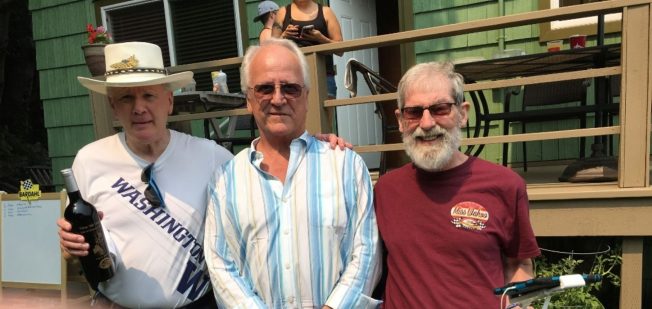 (Randy Short [right], James Wilson [left], Billy Schumacher [center], at an ATPBA race in 2017. Once nicknamed “Billy the Kid,” Schumacher was one of the most well-known hydroplane racers)
(Randy Short [right], James Wilson [left], Billy Schumacher [center], at an ATPBA race in 2017. Once nicknamed “Billy the Kid,” Schumacher was one of the most well-known hydroplane racers)
From their first races in 1950 to the present day, the Seattle skyline that James Wilson’s house on Victoria Avenue overlooks has changed drastically. The Smith Tower, once the tallest skyscraper on the West Coast, is now the 26th tallest in Seattle. Harbor Island businesses have continued to expand, the West Seattle Bridge has replaced the old drawbridge, Seattle has seen 16 mayors, the rise of the tech industry, the Civil Rights movement and more.
For each groundbreaking shift, each controversial election, and each new skyscraper on the skyline, though, Wilson has been right here. Even if this was their last race, and even if the city has changed in more ways than he can count, he says he’ll always remember the signature roar of piston engines over Lake Washington.
(Thanks to the neighbor whose tip enabled us to be there for the ATPBA’s finale.)

